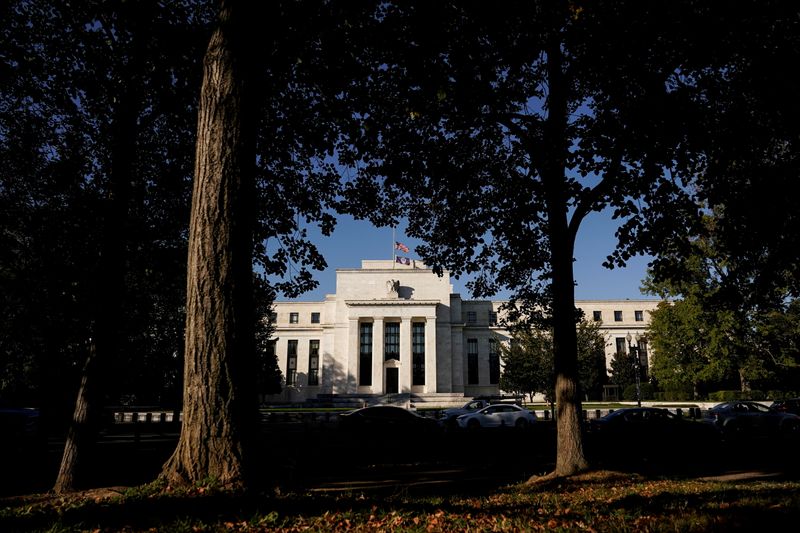Investing.com – Inflation continues to trend in the US and the country’s economy is still showing slow, albeit slow, growth, a delayed effect of US monetary policy that suggests a recession is not imminent. In a recent note, Evercore ISI
Look: The US Yield Curve
Analysts said business surveys conducted by Evercore measuring volumes and prices fell to 47.6 this week from 60.8 a few years ago.
“Recession rates start around 45.0. So we’re not there yet,” they explained, adding that their research on state sales tax collections continued to decline in July, despite slower growth and inflation.
A lagged effect of monetary policy has been driving the recession, Evercore ISI noted, with bank deposit and loan rates still around 2%; Credit card rates are above 20%, with unprecedented levels of tightening in the US and the Eurozone over the past week.
So far, however, the sheer volume of analysts’ positive S&P earnings revisions indicates the economy is still “very strong.”
Last week, S&P’s consensus estimate for second-quarter earnings rose to $243, up 10% from the same period last year.
However, there were an “unusual number of breaks” in the news last week, including layoff announcements by Cisco (NASDAQ: ), a decline in television business by Warner Bros. Discovery (NASDAQ: ) and Expedia’s warnings about declining travel, among others.
In terms of global inflation, China, the world’s second largest economy, “continued to export inflation in July,” they noted, pointing to softer inflation data coming out of China.
China’s producer price index fell month-on-month in July, while China’s core consumer price index showed a 0.0% change and increased just 0.4% from the previous month.
Supports soft landing actions
Likewise, stock strategists Wells Fargo (NYSE: ) predicts the U.S. economy will avoid a recession and steadily strengthen into next year. Relatedly, more flexible financial conditions should support continued growth in corporate profits and maintain the strength of equity markets, according to an investment bank report on Monday.
It’s been more than a year since the Federal Reserve last raised the federal funds rate. During this period of stability in monetary policy, stocks showed an upward trajectory and reached record highs. However, recent market volatility and weak economic indicators have raised speculation that the Fed may need to make more drastic rate cuts to stave off a US recession.
“Our expectation is that the Fed will cut rates in September, shifting focus from fighting inflation to stimulating the economy and job market,” Wells Fargo strategists said.
“While a recession is possible, our analyzes point to a higher likelihood of a temporary economic slowdown followed by a recovery in 2025.”
Historically, the central bank’s motivation to ease monetary policy has underpinned the performance of stock markets.
Since 1974, the average market decline in the 250 days following the Fed’s first rate cut has been about 20%, however, this average includes several bear markets associated with declining economies and earnings – unlikely for Wells Fargo in 2025.
A deeper look at the data shows a different picture during non-recession periods. Strategists point out that when the central bank cuts real rates in response to falling inflation rather than because of a rapid weakening of the economy, “stocks have done better.”
The S&P 500 generally continued its upward trend 18 months after initial rate cuts in periods when the Fed’s easing cycle did not coincide with a recession. Conversely, when rate cuts coincided with recessions, market performance remained fairly volatile over the 18-month period.
Strategists draw parallels between the current environment and the mid-to-late 1990s, particularly in 1995, when the Fed began a cycle of rate cuts during a period of inflation and an economic soft landing.
Despite the differences, strategists believe the situation in 1995 will guide corporate profits and stock prices in the coming quarters. Against that backdrop, the S&P 500 saw a 12% increase in profits in the year following the initial rate cut, close to Wells Fargo’s forecast.
While recognizing similarities with 1995, strategists also note that each cycle has its own unique characteristics. For example, inflation has peaked at very high rates during the current cycle, and the Fed has kept rates high for a long time.
“However, we believe the US economy will avoid recession and gradually strengthen through 2025,” they said.
“This, combined with more flexible financial conditions, should encourage continued corporate earnings growth, stock market strength and our preference for high-quality large-cap companies in the US.”
The S&P 500 ended virtually flat last week, recouping most of its losses on August 5.

“Internet addiction in terminals. Award-winning beer expert. Travel expert. General analyst.”







More Stories
Oil falls for 4th consecutive session on US stocks and conflict in Middle East – Money Times
Youth development in UK poultry farming is a new initiative in international production
Robert F. Kennedy Jr. considers abandoning campaign and endorsing Trump